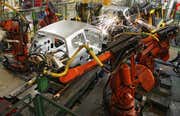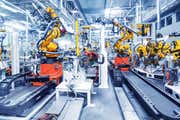Similar to the invention of the airplane, the emergence of automobiles has had a profound effect on our everyday lives.
The auto manufacturing industry is considered to be highly capital and labor intensive. The major osts for producing and selling automobiles include:
Over and above the labor and material costs we mentioned above, there are other developments in the automobile industry that you must consider when analyzing an automobile company. Globalization, the tendency of world investment and businesses to move from national and domestic markets to a worldwide environment, is a huge factor affecting the auto market. More than ever, it is becoming easier for foreign automakers to enter the North American market. (To read more about this issue, see The Globalization Debate.)
Competition is the other factor that takes its toll on the auto industry; we will discuss this in more detail below under the Porter's 5 forces analysis
Key Players
In North America, the automobile production market is dominated by what's known as the Big Three:
Fleet Sales: Traditionally, these are high-volume sales designated to come from large companies and government agencies. These sales are almost always at discount prices. In the past several years, auto makers have been extending fleet sales to small businesses and other associations.
Seasonally Adjusted Annual Rate of Sales (SAAR): Most auto makers experience increased sales during the second quarter (April to June), and sales tend to be sluggish between November and January. For this reason, it is important to compare sales figures to the same period of the previous year. The adjustment factors are released each year by the U.S. Bureau of Economic Analysis.
Sales Reports: Many of the large auto makers release their preliminary sales figures from the previous month on a monthly basis. This can give you an indication of the current trends in the industry.
Day Sales Inventory = Average Inventory
Average Daily Sales
The sales reports (discussed above) are released monthly. Most automakers try to make dealerships hold 60 days worth of inventory on their lots. Watch out if sales inventory climbs significantly above 60 days worth. Sales fluctuate month-to-month, but you shouldn't see sustained periods of high inventory.
Analyst Insight
Automobiles depend heavily on consumer trends and tastes. While car companies do sell a large proportion of vehicles to businesses and car rental companies (fleet sales), consumer sales is the largest source of revenue. For this reason, taking consumer and business confidence into account should be a higher priority than considering the regular factors like earnings growth and debt load. (For more about the Consumer Confidence Survey, see Economic Indicators: Consumer Confidence Index.)
Another caveat of analyzing an automaker is taking a look at whether a company is planning makeovers or complete redesigns. Every year, car companies update their cars. This is a part of normal operations, but there can be a problem when a company decides to significantly change the design of a car. These changes can cause massive delays and glitches, which result in increased costs and slower revenue growth. While a new design may pay off significantly in the long run, it's always a risky proposition.
For parts suppliers, the life span of an automobile is very important. The longer a car stays operational, the greater the need for replacement parts. On the other hand, new parts are lasting longer, which is great for consumers, but is not such good news for parts makers. When, for example, most car makers moved from using rolled steel to stainless steel, the change extended the life of parts by several years.
A significant portion of an automaker's revenue comes from the services it offers with the new vehicle. Offering lower financial rates than financial institutions, the car company makes a profit on financing. Extended warranties also factor into the bottom line. (To read more about this, see Extended Warranties: Should You Take The Bait?)
Greater emphasis on leasing has also helped increase revenues. The advantage of leasing is that it eases consumer fears about resale value, and it makes the car sound more affordable. From a maker's perspective, leasing is a great way to hide the true price of the vehicle through financing costs. Car companies, then, are able to push more cars through. Unfortunately, profiting on leasing is not as easy as it sounds. Leasing requires the automakers to accurately judge the value of their vehicles at the end of the lease, otherwise they may actually lose money. If you think about it, the automaker will lose money on the lease if they give the car a high salvage value. A car with a low salvage value at the end of the lease will simply be bought by the consumer and flipped for a profit.
Porter's 5 Forces Analysis
Key Links
The Industry Handbook: The Retailing Industry
The auto manufacturing industry is considered to be highly capital and labor intensive. The major osts for producing and selling automobiles include:
- Labor - While machines and robots are playing a greater role in manufacturing vehicles, there are still substantial labor costs in designing and engineering automobiles.
- Materials - Everything from steel, aluminum, dashboards, seats, tires, etc. are purchased from suppliers.
- Advertising - Each year automakers spend billions on print and broadcast advertising; furthermore, they spent large amounts of money on market research to anticipate consumer trends and preferences.
- Original Equipment Manufacturers (OEMs) - The big auto manufacturers do produce some of their own parts, but they can't produce every part and component that goes into a new vehicle. Companies in this industry manufacture everything from door handles to seats.
- Replacement Parts Production and Distribution - These are the parts that are replaced after the purchase of a vehicle. Air filters, oil filers and replacement lights are examples of products from this area of the sector.
- Rubber Fabrication - This includes everything from tires, hoses, belts, etc.
Over and above the labor and material costs we mentioned above, there are other developments in the automobile industry that you must consider when analyzing an automobile company. Globalization, the tendency of world investment and businesses to move from national and domestic markets to a worldwide environment, is a huge factor affecting the auto market. More than ever, it is becoming easier for foreign automakers to enter the North American market. (To read more about this issue, see The Globalization Debate.)
Competition is the other factor that takes its toll on the auto industry; we will discuss this in more detail below under the Porter's 5 forces analysis
Key Players
In North America, the automobile production market is dominated by what's known as the Big Three:
- General Motors - Produces Chevrolet, Pontiac, Buick and Cadillac, among others.
- Chrysler - Chrysler, Jeep and Dodge.
- Ford Motor Co - Ford, Lincoln and Volvo.
- Toyota Motor Co
- Honda Motor Co
Fleet Sales: Traditionally, these are high-volume sales designated to come from large companies and government agencies. These sales are almost always at discount prices. In the past several years, auto makers have been extending fleet sales to small businesses and other associations.
Seasonally Adjusted Annual Rate of Sales (SAAR): Most auto makers experience increased sales during the second quarter (April to June), and sales tend to be sluggish between November and January. For this reason, it is important to compare sales figures to the same period of the previous year. The adjustment factors are released each year by the U.S. Bureau of Economic Analysis.
Sales Reports: Many of the large auto makers release their preliminary sales figures from the previous month on a monthly basis. This can give you an indication of the current trends in the industry.
Day Sales Inventory = Average Inventory
Average Daily Sales
The sales reports (discussed above) are released monthly. Most automakers try to make dealerships hold 60 days worth of inventory on their lots. Watch out if sales inventory climbs significantly above 60 days worth. Sales fluctuate month-to-month, but you shouldn't see sustained periods of high inventory.
Analyst Insight
Automobiles depend heavily on consumer trends and tastes. While car companies do sell a large proportion of vehicles to businesses and car rental companies (fleet sales), consumer sales is the largest source of revenue. For this reason, taking consumer and business confidence into account should be a higher priority than considering the regular factors like earnings growth and debt load. (For more about the Consumer Confidence Survey, see Economic Indicators: Consumer Confidence Index.)
Another caveat of analyzing an automaker is taking a look at whether a company is planning makeovers or complete redesigns. Every year, car companies update their cars. This is a part of normal operations, but there can be a problem when a company decides to significantly change the design of a car. These changes can cause massive delays and glitches, which result in increased costs and slower revenue growth. While a new design may pay off significantly in the long run, it's always a risky proposition.
For parts suppliers, the life span of an automobile is very important. The longer a car stays operational, the greater the need for replacement parts. On the other hand, new parts are lasting longer, which is great for consumers, but is not such good news for parts makers. When, for example, most car makers moved from using rolled steel to stainless steel, the change extended the life of parts by several years.
A significant portion of an automaker's revenue comes from the services it offers with the new vehicle. Offering lower financial rates than financial institutions, the car company makes a profit on financing. Extended warranties also factor into the bottom line. (To read more about this, see Extended Warranties: Should You Take The Bait?)
Greater emphasis on leasing has also helped increase revenues. The advantage of leasing is that it eases consumer fears about resale value, and it makes the car sound more affordable. From a maker's perspective, leasing is a great way to hide the true price of the vehicle through financing costs. Car companies, then, are able to push more cars through. Unfortunately, profiting on leasing is not as easy as it sounds. Leasing requires the automakers to accurately judge the value of their vehicles at the end of the lease, otherwise they may actually lose money. If you think about it, the automaker will lose money on the lease if they give the car a high salvage value. A car with a low salvage value at the end of the lease will simply be bought by the consumer and flipped for a profit.
Porter's 5 Forces Analysis
- Threat of New Entrants. It's true that the average person can't come along and start manufacturing automobiles. Historically, it was thought that the American automobile industry and the Big Three were safe. But this did not hold true when Honda Motor Co. opened its first plant in Ohio. The emergence of foreign competitors with the capital, required technologies and management skills began to undermine the market share of North American companies.
- Power of Suppliers. The automobile supply business is quite fragmented (there are many firms). Many suppliers rely on one or two automakers to buy a majority of their products. If an automaker decided to switch suppliers, it could be devastating to the previous supplier's business. As a result, suppliers are extremely susceptible to the demands and requirements of the automobile manufacturer and hold very little power.
- Power of Buyers. Historically, the bargaining power of automakers went unchallenged. The American consumer, however, became disenchanted with many of the products being offered by certain automakers and began looking for alternatives, namely foreign cars. On the other hand, while consumers are very price sensitive, they don't have much buying power as they never purchase huge volumes of cars.
- Availability of Substitutes. Be careful and thorough when analyzing this factor: we are not just talking about the threat of someone buying a different car. You need to also look at the likelihood of people taking the bus, train or airplane to their destination. The higher the cost of operating a vehicle, the more likely people will seek alternative transportation options. The price of gasoline has a large effect on consumers' decisions to buy vehicles. Trucks and sport utility vehicles have higher profit margins, but they also guzzle gas compared to smaller sedans and light trucks. When determining the availability of substitutes you should also consider time, money, personal preference and convenience in the auto travel industry. Then decide if one car maker poses a big threat as a substitute.
- Competitive Rivalry. Highly competitive industries generally earn low returns because the cost of competition is high. The auto industry is considered to be an oligopoly, which helps to minimize the effects of price-based competition. The automakers understand that price-based competition does not necessarily lead to increases in the size of the marketplace; historically they have tried to avoid price-based competition, but more recently the competition has intensified - rebates, preferred financing and long-term warranties have helped to lure in customers, but they also put pressure on the profit margins for vehicle sales.
Key Links
- Ward's Automotive Reports - A popular publisher of automotive data.
- The Alliance of Automobile Manufacturers - Get the latest industry facts, developments, and technological innovations.
- Automotive Industries - A magazine covering several areas of the auto industry.
- US Council for Automobile Research - The umbrella organization of Daimler Chrysler, Ford and General Motors created to strengthen the technology base of the domestic auto industry.
The Industry Handbook: The Retailing Industry
Related Articles
-
 Managing Wealth
Managing WealthAnalyzing Auto Stocks
Find out what to consider before taking a ride with stocks from this industry. -
 Investing
InvestingDo Oil Prices Affect The Auto Industry?
Based on an understanding of complementary and substitute goods, the American auto industry is exhibiting expected effects from the recent plunge in the price of oil. -
 Investing
InvestingIs the Used Car Industry in Trouble?
Usually, if new car sales go down, it's good news for used cars. Not this time. -
 Personal Finance
Personal FinanceAutoNation Numbers Confirm U.S. Auto Sales Slump
AutonNation has provided the latest evidence that demand for cars and trucks in the U.S. is slowing. -
 Investing
InvestingBig Tech M&A Is Transforming the Auto Industry
Tech companies are racing to secure a foothold in what could become a $70 billion market, Intel says. -
 Insights
InsightsMost Profitable Automobile Companies of 2016 (HMC, TM)
There are only four really profitable automobile companies in 2016 as the market has not supported prices despite a projection of near record sales. -
 Managing Wealth
Managing WealthWhen Is Leasing a Car Your Best Bet?
Leasing a car isn't for everyone. But it's attractive for those who want low initial payments and the ability to get a new vehicle every few years. -
 Managing Wealth
Managing WealthYour Lease Is Up: When Should You Buy the Car?
Deciding whether to buy your leased car is fraught with challenges. Learn how to assess the benefits and pitfalls and how they can help you choose. -
 Investing
InvestingTop 3 Auto Industry ETFs in 2017
These three auto industry investment vehicles have been top performers in 2017. -
 Personal Finance
Personal Finance3 Questions to Consider When Buying a Car
When deciding what kind of car to buy, make sure to answer these questions first.



